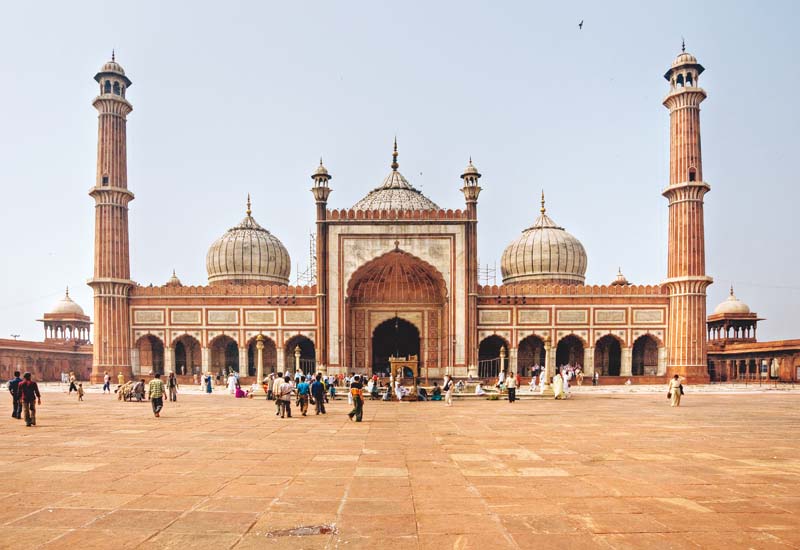
The corridors of power have also shifted: from the walled city of Dilli to Britain’s colonial settlement of New Delhi. And as with any city, Delhi’s monuments are a symbol of its glorious past.
One such towering structure is the 15th century tomb of second Mughal emperor Humayun. On this particular balmy Sunday afternoon, a thumping sound punctuates the chirping of birds. Three young craftsmen are at work at the tomb, recreating a part of history.
“These craftsmen are making different colourful tiles which will replace the ones on the tomb’s façade,” explains Salahuddin Saifi, who supervises a small factory. Around nine young local men are making the tiles using techniques taught by craftsmen from Uzbekistan.

Parliament House in New Delhi was constructed in 1921. PHOTOS: ATHAR KHAN
One can imagine similar sounds reverberating through the neighbourhood when the tomb was first being built in 1572. Four and a half centuries later, the monument has been declared a world heritage site.
Unlike their predecessors, the craftsmen working on the tomb’s renovation are aided by a machine that mixes materials and gives the tiles their different shapes. The tiles are then baked in a small kiln for three days.
“The tiles first used to decorate the tomb lasted for over 400 years. We’re using the same material and expect the new ones to survive another 400 years,” says Saifi.
The tomb is among the 6,000 other historic monuments being repaired in India under a massive renovation project, believed to the first of its kind in regional countries like Pakistan, Afghanistan, Burma and Bangladesh.
“They (the workers) don’t even know the importance of the job they’re undertaking. They are preserving history,” Ditti Ray, programme officer for Cultural Revival at the Aga Khan Trust for Culture, told The Express Tribune.
The trust is one of the groups providing technical and financial assistance to the Indian government to preserve thousands of monuments across the country. The Indian National Trust for Art and Culture (INTACH), an NGO, is leading the project.
Through the times
Historians speak of the seven cities of Delhi at the time of the Muslim conquest of Northern India at the end of the 12th century. However, there were actually eight cities from 100 and 1947 AD. These included the oldest city near the site of the Qutub Minar, Siri, Tughlaqabad, Jahanpanah, Firozabad, the city around Purana Qila, Shahjahanabad and New Delhi.

Mohammad Shah’s tomb at Lodi Gardens. PHOTOS: ATHAR KHAN
AGK Menon, a professor of conservation architecture, says Delhi has a rich and varied history. “It’s very complex and tangible, it’s intermingling: the crafts, dance, music, etc. But it was slowly vanishing because no one was paying attention,” adds Menon, who is the convener of the Delhi chapter of INTACH.
“We do not only want to the see the heritage as monuments, but instead as a mixture of daily activities. You talk of intangible heritage, the songs, the music, the paintings and the dance. We are able to look at it as a composite whole,” says the convener, proudly sharing that INTACH has successfully documented 1,200 monuments in Delhi alone, of which more than half are those built by the Mughals.
A matter of faith
“This is where the composite nature of heritage emerges. It’s not about Hinduism, Islam, Buddhism or Christianity. This is very clear in our architecture, which may be called Indo-Islamic,” explains Menon.
The places where conservation work is underway include three UNESCO world heritage sites of the Red Fort, Qutub Minar and Humayun’s tomb. Other famous heritage sites include Jamia Masjid and Sikandar Lodhi Gardens, among others.
“Once we withdraw from a site after completing restoration work, community members are engaged to ensure sustainability,” says Ajay Kumar, Director Operation of INTACH’s Delhi chapter.
“The heritage does not have any religion. Whenever such questions arise, we say we’re preserving heritage, not religion,” reiterates Kumar.
On the flip side, Professor Menon maintains that the preservation of both Hindu and Muslim monuments can help foster interfaith harmony. “People forget that Islam is also a diverse religion and has diverse expression. We need to have things that bind us and these monuments remind us that we really are one people with one culture,” he says.
“Somehow, in our countries, we do not feel a city can be a heritage. For us, heritage is just monuments. But go to Lahore’s Walled City and you’ll find the craftsmen, musicians, literary people and painters. You don’t look at it as a heritage, but it is.”
Naeem Sahoutra is a Karachi-based reporter for The Express Tribune. He tweets @NaeemSahoutara
Published in The Express Tribune, Sunday Magazine, September 27th, 2015.

















COMMENTS
Comments are moderated and generally will be posted if they are on-topic and not abusive.
For more information, please see our Comments FAQ